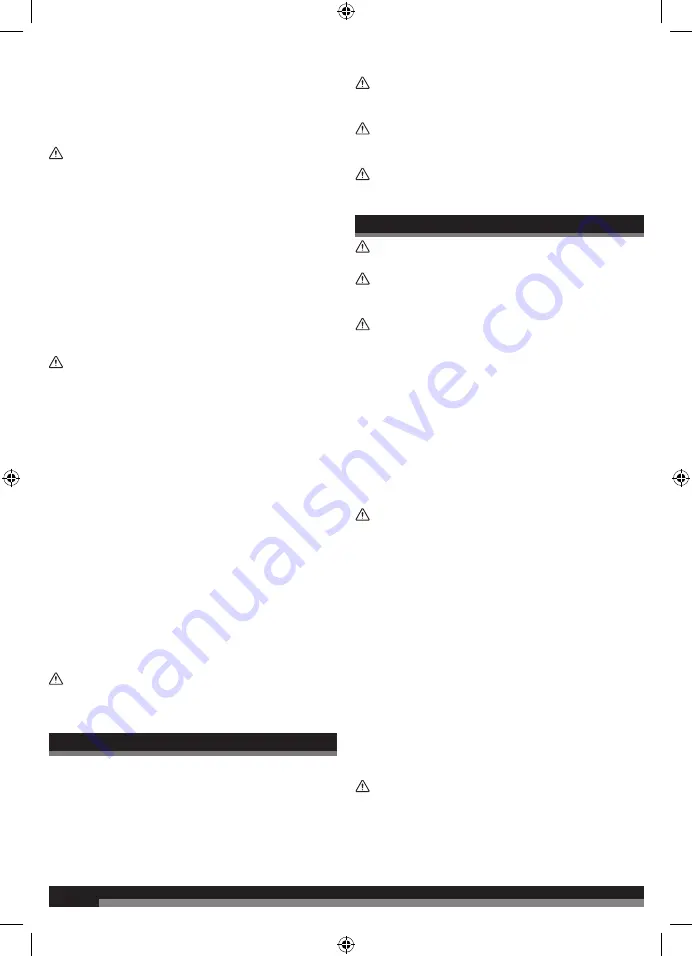
10
10
11. When finished, always drain the tank and unplug the unit. Never
leave the unit plugged in and/or running unattended.
12. It is recommended to use a residual current device with a rated
residual current of 30 mA or less.
CHECKING THE PRESSURE RELIEF VALVE
See figure 10.
WARNING!
Do not attempt to tamper with the safety valve.
Anything loosened from this device could fly up and hit you. Failure
to heed this warning could result in death or serious personal injury.
The pressure relief valve will automatically release air if the air tank
pressure exceeds the preset maximum, and will stop releasing air
once the tank pressure drops to within the preset minimum.
1. Turn the air compressor on and allow the tank to fill. The
compressor will shut off when the pressure reaches the preset
maximum.
2. Turn the air compressor off.
3. Rotate the pressure relief valve counterclockwise to release air
for three to five seconds. Air should rapidly escape. Rotate the
pressure relief valve clockwise, and the air should stop escaping.
Keep the pressure relief valve clean and do not cover it with any
object.
WARNING!
If air leaks after the pressure relief valve has been
closed, or if the valve is stuck and cannot be actuated, do not use the
air compressor until the pressure relief valve has been replaced. Use
of the air compressor in this condition could result in serious personal
injury.
DRAINING THE TANK
See figure 10-11.
To prevent tank corrosion and keep moisture out of the air used, the
air tank of the compressor should be drained daily.
To drain:
1. Turn the air compressor off.
2. Rotate the pressure relief valve counterclockwise until the tank
pressure gauge reads less than 1.4 bar (20 PSI).
3. Turn the drain valve lever counterclockwise to open the drain
valve and drain the moisture.
NOTE:
Condensate is a polluting material and should be disposed
of in compliance with local regulations.
4. Rotate the pressure relief valve clockwise to close.
5. If drain valve is clogged, attach an air blow gun to the compressor
and release the pressure from the tank. Remove and clean the
drain valve, then reinstall.
DANGER!
Unplug the air compressor and release all air from the
tank before servicing. Failure to depressurise tank before attempting
to remove valve may cause serious personal injury.
6. Rotate drain valve lever clockwise until tightly closed.
STORAGE
1. Push the power switch to the OFF position to turn off the
compressor.
2. Unplug the compressor.
3. Run the air tool to relieve the air pressure in the hose, then
remove the air hose and the tool, or release the pressure from the
tank by the drain valve.
4. Drain water from the tank as instructed in Draining the Tank
section. Leave the valve open until the next usage.
5. Store the air compressor in its normal operating position in a dry
and protected area.
WARNING!
Water will condense in the air compressor tank when
the compressor is in operation. Water left in the tank can cause the
tank to weaken and corrode, increasing the risk of tank rupture.
WARNING!
Always disconnect the air hose from tools whenever
not in use or while servicing. During maintenance, a tool connected
to air hose may operate accidentally, causing serious personal injury!
WARNING!
Failure to unplug the air compressor before
storage may result in the compressor running continuously, causing
overheating, damage to the compressor, and possibly a fire.
MAINTENANCE
WARNING!
When servicing use only original replacement parts.
Use of any other parts may create a hazard or cause product damage.
WARNING!
Always wear eye protection with side shields. Failure
to do so could result in objects being thrown into your eyes resulting
in possible serious injury.
WARNING!
Always release all pressure, disconnect from power
supply, and allow unit to cool before cleaning or making repairs on
the air compressor.
GENERAL MAINTENANCE
Avoid using solvents when cleaning plastic parts. Most plastics are
susceptible to damage from various types of commercial solvents and
may be damaged by their use. Use clean cloths to remove dirt, dust,
oil, grease, etc.
Do not modify this product in any way or use accessories not
approved by the manufacturer. Your safety and that of others may
be compromised.
Disconnect the power supply before making adjustments or when
doing any maintenance on the machine.
WARNING!
Do not at any time let brake fluids, gasoline,
petroleum-based products, penetrating oils, etc., come in contact with
plastic parts. Chemicals can damage, weaken or destroy plastic which
may result in serious personal injury.
REPLACING AIR FILTERS
See figure 12.
Follow the instructions below to replace the air filters:
Normal environment
Check and clean the filters once a month. Replace damaged or heavily
clogged filters.
Heavy-dust environment
Check and clean the filters once a week. Replace damaged or heavily
clogged filters.
To replace an air filter:
1. Remove the air filter by turning counterclockwise.
2. Attach a new air filter and rotate clockwise to secure.
WARNING!
For greater safety and reliability, all repairs should be
performed by an authorised AEG service centre.
Use only AEG accessories and spare parts. Should components need
to be replaced which have not been described, please contact one of
our AEG service agents (see our list of guarantee/service addresses).
Summary of Contents for AC30100S
Page 1: ...AC30100S Original instructions ...
Page 14: ...14 14 PARTS LIST ...


































